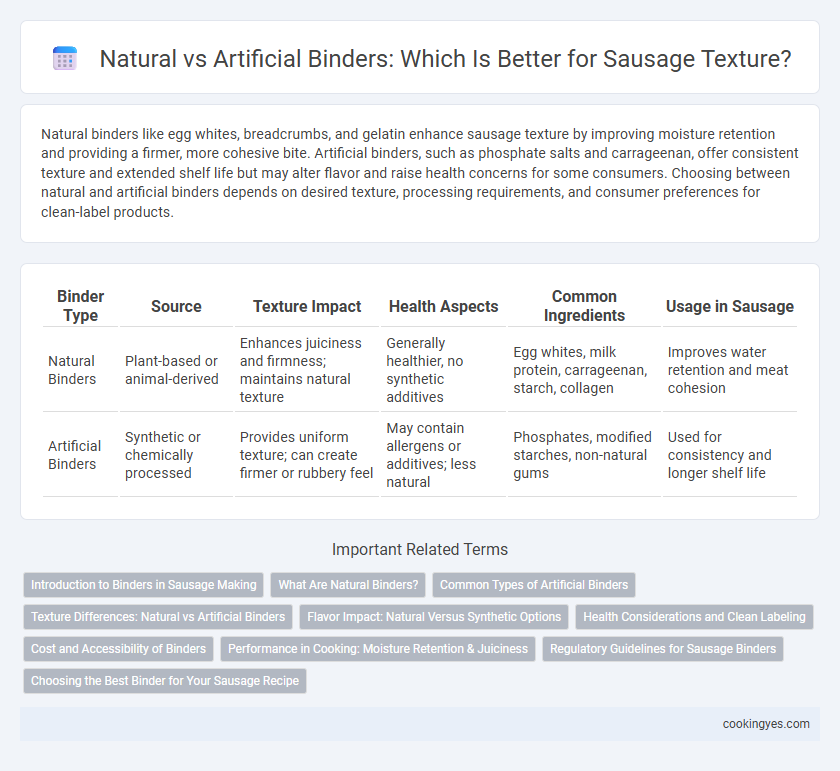Natural binders like egg whites, breadcrumbs, and gelatin enhance sausage texture by improving moisture retention and providing a firmer, more cohesive bite. Artificial binders, such as phosphate salts and carrageenan, offer consistent texture and extended shelf life but may alter flavor and raise health concerns for some consumers. Choosing between natural and artificial binders depends on desired texture, processing requirements, and consumer preferences for clean-label products.
Table of Comparison
| Binder Type | Source | Texture Impact | Health Aspects | Common Ingredients | Usage in Sausage |
|---|---|---|---|---|---|
| Natural Binders | Plant-based or animal-derived | Enhances juiciness and firmness; maintains natural texture | Generally healthier, no synthetic additives | Egg whites, milk protein, carrageenan, starch, collagen | Improves water retention and meat cohesion |
| Artificial Binders | Synthetic or chemically processed | Provides uniform texture; can create firmer or rubbery feel | May contain allergens or additives; less natural | Phosphates, modified starches, non-natural gums | Used for consistency and longer shelf life |
Introduction to Binders in Sausage Making
Natural binders in sausage making, such as soy protein, egg whites, and starches from potatoes or rice, improve texture by enhancing water retention and cohesion of meat particles. Artificial binders like carrageenan, modified cellulose, and synthetic phosphates provide consistent binding effects and extended shelf life but may lack the clean-label appeal preferred by consumers. Selecting the appropriate binder depends on product formulation, desired texture, and regulatory considerations for additive use in processed meats.
What Are Natural Binders?
Natural binders in sausages are ingredients derived from plant or animal sources that help retain moisture and improve texture without synthetic additives. Common natural binders include egg whites, milk proteins, and starches from potatoes or tapioca, which enhance juiciness and cohesiveness in the sausage mix. These binders contribute to a firmer bite and prevent separation of fat and meat during cooking, offering a cleaner label alternative preferred in artisanal and health-focused products.
Common Types of Artificial Binders
Common types of artificial binders in sausage production include carrageenan, sodium caseinate, and modified starches, each enhancing texture and moisture retention. Carrageenan, derived from red seaweed, forms a gel that improves juiciness and firmness, while sodium caseinate, a milk protein, enhances emulsification and bite. Modified starches, chemically altered from native starches, increase water binding and gel stability, contributing to a consistent and appealing sausage texture.
Texture Differences: Natural vs Artificial Binders
Natural binders in sausages, such as carrageenan, potato starch, and egg whites, create a tender, moist texture by retaining water and improving bite consistency. Artificial binders like soy protein concentrate and modified cellulose offer a firmer, more uniform texture but may result in a less natural mouthfeel. These texture differences influence consumer preference and product quality, with natural binders often favored for traditional, artisanal sausages and artificial binders used in mass-produced varieties.
Flavor Impact: Natural Versus Synthetic Options
Natural binders in sausages, such as egg whites, milk proteins, and plant-based fibers, enhance texture while contributing subtle, complementary flavors that preserve the product's authentic taste profile. Synthetic binders, like sodium caseinate or modified starches, offer consistent texture improvements but may introduce bland or chemical notes that can alter the sausage's original flavor balance. Choosing natural binders supports a cleaner taste and better consumer perception by avoiding off-flavors associated with artificial additives.
Health Considerations and Clean Labeling
Natural binders such as carrageenan, guar gum, and xanthan gum enhance sausage texture while aligning with clean labeling trends by avoiding synthetic additives linked to health concerns like allergic reactions and digestive issues. Artificial binders, including modified starches and sodium caseinate, may improve product consistency but often raise consumer skepticism due to potential chemical residues and lack of transparency. Prioritizing natural binders supports health-conscious consumers seeking minimally processed foods with recognizable, simple ingredients.
Cost and Accessibility of Binders
Natural binders for sausage, such as starches and plant fibers, offer cost-effective and widely accessible options due to their abundance and lower price points in comparison to artificial binders. Artificial binders, including synthetic gels and modified food starches, often involve higher production costs and may be less readily available in certain regions, impacting overall manufacturing expenses. Choosing natural binders supports affordability and supply chain stability, making them a preferred option for many sausage producers prioritizing cost efficiency and accessibility.
Performance in Cooking: Moisture Retention & Juiciness
Natural binders in sausage production, such as potato starch and carrageenan, excel in moisture retention by forming a gel matrix that traps water, resulting in a juicier cooked product. Artificial binders like phosphates enhance water-holding capacity by altering protein interactions, improving texture stability and reducing cooking losses. Choosing the right binder influences the final sausage's tenderness, succulence, and overall sensory quality during thermal processing.
Regulatory Guidelines for Sausage Binders
Regulatory guidelines for sausage binders emphasize the use of approved substances to ensure food safety and consumer health, with natural binders such as carrageenan and cellulose derived from plant sources often preferred for their clean label appeal. Artificial binders like sodium triphosphates and modified starches must meet strict limits set by food safety authorities such as the FDA and EFSA, with detailed labeling requirements to inform consumers. Compliance with these regulations ensures consistent sausage texture, prevents adulteration, and supports market acceptance.
Choosing the Best Binder for Your Sausage Recipe
Natural binders like eggs, breadcrumbs, and ground oats enhance sausage texture by improving moisture retention and providing a tender bite, ideal for artisanal recipes prioritizing clean labels. Artificial binders such as phosphates and carrageenan offer consistent binding and increased water-holding capacity, optimizing yield and firmness in mass-produced sausages. Selecting the best binder depends on balancing desired texture, ingredient transparency, and processing requirements specific to your sausage formulation.
Natural binders vs artificial binders for sausage texture Infographic

 cookingyes.com
cookingyes.com